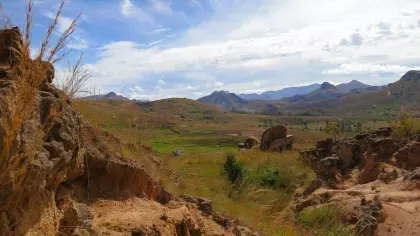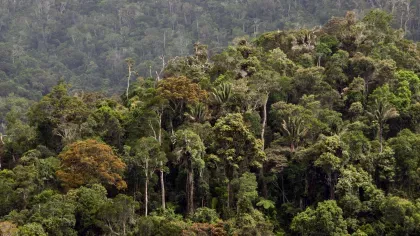Mycorrhizal research supports orchid conservation in Madagascar
Madagascar is home to more than 1,000 species of orchid of which about 90% are endemic. Kew’s Head of Conservation Biotechnology, Viswambharan Sarasan, describes progress in the identification of orchid mycorrhizae, and how this could help future orchid conservation and restoration programmes.

Orchids in a biodiversity hotspot
Around 44% of the world's vascular plant species occur in 34 global biodiversity hotspots (Mittermeier et al. 2005). Madagascar is one of the hottest of these hotspots with a very high species endemism, especially for orchids - the island accounts for 0.4% of the world’s land mass, but is home to 4% of all known orchids. More than 50 of these orchid taxa are found in the Itremo Massif within the Central Highlands of Madagascar and the majority are endemic to Madagascar (i.e. found nowhere else), with some, such as Angraecum protensum and A. coutrixii, found only in the Itremo region.
The restricted distribution of many Madagascan orchids makes them particularly vulnerable to loss of habitat. Slash and burn agriculture is a common practice, as the majority of the population live by subsistence farming. During field studies in Itremo we observed evidence of fire damage on two separate rocky ridges and speculate that adjacent man-made grass fires were the cause. In addition to this, illegal mining for precious stones is causing habitat degradation in some areas (Vorontsova et al. 2013).
As a result of their restricted distribution and threats to their habitats, many Madagascan orchid species have suffered a decline and require active conservation management. These and other orchids rely on fungal partners known as mycorrhizae to enable them to germinate and grow, and it is therefore important to understand the relationship between orchids and their mycorrhizae to ensure the success of conservation programmes.
Studying orchid mycorrhizae for conservation and phylogeny
The Itremo Massif consists of a plateau of mixed igneous and metamorphic rock at an elevation of 1400-1923m above sea level. The average temperature is in the range of 18-21 degrees Celsius, with annual rainfall of 1416 mm and a 4-6 month dry season. The diversity of ecosystem types strewn across this unique land mass offers a great opportunity to study orchid and mycorrhizal fungal diversity.
Detailed studies on the mycorrhizal fungi associated with these orchids have not previously been carried out, and yet understanding the role of mycorrhizal fungi on seed germination and further growth is the key to developing orchid conservation models. Historically, seed baiting was used in other parts of the world to study orchid fungi. This method was developed by Rasmussen et al. (1993), and involves placing seeds within a nylon mesh packet that fungi can penetrate. However this method is unpredictable and it usually takes a long time for successful baiting to happen, while loss of baits is also a risk (Gale et al., 2010).
As modern molecular screening methods supported by Next Generation Sequencing technologies are evolving all the time, there is now a great opportunity to study these symbionts for both conservation and phylogenetic (evolutionary) relationships. Reintroductions using progeny grown without their natural fungal symbionts may not be sustainable, as natural regeneration may not occur following reintroduction if the ecosystem has not been assessed for the presence of these fungal partners. This prompted us to study the orchid-mycorrhizal relationships which could one day help save some of the very rare orchids that are on the brink of extinction.
What we have learned
To our knowledge this is the first time that a detailed screening has been attempted, to identify fungal symbionts of Madagascan orchids. Since our own previous baiting trials using the standard baiting method were unsuccessful we decided to test root samples from plants in the wild, i.e. roots from both seedlings and mature phase plants to identify the full suite of fungi. With good quality wild-collected material this method could allow mycorrhizal screening within a very short window of time. It could also reveal the full suite of other fungal endophytes which may have a role to play, depending on the ecosystem and species.
In our study, the collected root cortical tissue was macerated to release the fungal mycelial coils (peloton) and cultured on a growth medium for further work. DNA was also isolated and the nuclear ITS region was sequenced. This is a variable part of DNA that enables us to distinguish between related groups of individuals based on similarities and differences in the genetic sequence. DNA sequences of hundreds of isolates that matched Rhizoctonia-like fungi, were aligned and grouped into clusters of similar sequences that we can define as operational taxonomic units (OTUs).
Without further work on morphology and other DNA regions, it is not possible to say exactly how many species are present but OTUs allow us to define the number of clusters of closely related individuals. We have also identified three distinct mycorrhizal fungal genera from these groupings. About 15 OTUs have been identified across these three genera.
Implications of this work
We have observed more than a 10 fold increase in germination in some orchids when the most suitable mycorrhizal fungus was grown with the seeds, compared to seed grown without any fungus. Furthermore, in some cases seed germination took less than one fifth of the time for seeds grown with fungus, compared to those grown without. We have also successfully germinated one Aerangis sp. using the correct fungus where it was impossible without a fungus. This species is slowly drifting into extinction due to pollination problems, inbreeding and lack of natural regeneration. We are currently carrying out large scale screening and germination trials to identify orchids that are generalists and those that require a specific fungus. This will help to understand more about the requirements for reintroduction of orchids back to the wild.
Cryopreservation
Although orchid seeds are generally tolerant of desiccation, longevity in storage is poor in many cases. Merritt et al. (2014) proposed that cryopreservation of orchid seeds may be a better approach. To date only very limited work has been carried out on storing both seeds and the mycorrhizal fungus together in a cryopreservation system as described by Sommerville et al. (2008). This system has great potential in the coming decade as orchid-mycorrhizal systems become increasingly well studied. A faster and better recovery of stored orchid propagules will open up opportunities to apply the techniques to numerous threatened orchid species, and this will be particularly important for those found in fragmented ecosystems and with only a few populations/individuals left in the wild.
Future areas of work
Future areas of work include the identification of the full suite of fungi that we can isolate from targeted collection of orchid taxa of high conservation and scientific interest. This will allow identification of those fungal partners that are required for the orchid to germinate and grow, enabling the establishment of sustainable populations when they are reintroduced back into the wild. There may be opportunities in future to manipulate degraded ecosystems at micro-habitat level to enhance germination and seedling survival.
Further understanding of the potential of this method will unlock a wealth of information that can be used to help the conservation of orchids in biodiversity hotspots around the world.
References
Gale, S.W., Yamazaki, J., Hutchings, M.J., Yukawa, T. & Miyoshi, K. (2010). Constraints on establishment in an endangered terrestrial orchid: a comparative study of in vitro and in situ seed germinability and seedling development in Nervilia nipponica. Botanical Journal of the Linnaean Society 163: 166-180. Available online
Merritt, D.J., Hay, F.R., Swarts, N.D., Sommerville, K.D. & Dixon, K.W. (2014). Ex situ conservation and cryopreservation of orchid germplasm. International Journal of Plant Sciences 175: 46-58. DOI: 10.1086/673370. Available online
Mittermeier, R.A., Robles Gil., P., Hoffman, M., Pilgrim, J., Brooks, T., Mittermeier, C.G., Lamoreux, J. & da Fonseca, G.A.B. (2005). Hotspots Revisited: Earth’s Biologically Richest and Most Endangered Terrestrial Ecoregions. University of Chicago Press, Chicago, USA.
Rasmussen, H.N. & Whigham, D.F. (1993). Seed ecology of dust seeds in situ: a new study technique and its application to terrestrial orchids. American Journal of Botany 80: 1374-1378. Available online
Somerville, K.D., Siemon, J.P., Wood, C.B. & Offord, C.A. (2008). Simultaneous encapsulation of seed and mycorrhizal fungi for long-term storage and propagation of terrestrial orchids. Australian Journal of Botany 56:609-615 DOI: 10.1071/BT08008. Available online
Vorontsova, M.S., G. Ratovonirina. & Randriamboavonjy, T. (2013). Revision of Andropogon and Diectomis (Poaceae: Sacchareae) in Madagascar and the new Andropogon itremoensis from the Itremo Massif. Kew Bulletin 68: 1-15. Available online


